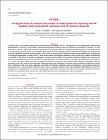| dc.contributor.author | HOLLAND, CELIA | en |
| dc.date.accessioned | 2016-10-05T10:32:52Z | |
| dc.date.available | 2016-10-05T10:32:52Z | |
| dc.date.issued | 2013 | en |
| dc.date.submitted | 2013 | en |
| dc.identifier.citation | Celia V Holland & Clare M Hamilton, The significance of cerebral toxocariasis: a model system for exploring the link between brain involvement, behaviour and the immune response, The Journal of Experimental Biology, 216, 2013, 78 - 83 | en |
| dc.identifier.other | Y | en |
| dc.identifier.uri | http://hdl.handle.net/2262/77467 | |
| dc.description | PUBLISHED | en |
| dc.description.abstract | Toxocara canis is a parasitic nematode that infects canines worldwide, and as a consequence of the widespread environmental dissemination of its ova in host faeces, other abnormal hosts including mice and humans are exposed to infection. In such abnormal or paratenic hosts, the immature third-stage larvae undergo a somatic migration through the organs of the body but fail to reach maturity as adult worms in the intestine. The presence of the migrating larvae contributes to pathology that is dependent upon the intensity of infection and the location of the larvae. A phenomenon of potential public health significance in humans and of ecological significance in mice is that T. canis larvae exhibit neurotrophic behaviour, which results in a greater concentration of parasites in the brain, as infection progresses. Toxocara larval burdens vary between individual outbred mice receiving the same inocula, suggesting a role for immunity in the establishment of cerebral infection. Although the systemic immune response to T. canis has been widely reported, the immune response in the brain has received little attention. Differential cytokine expression and other brain injury-associated biomarkers have been observed in infected versus uninfected outbred and inbred mice. Preliminary data have also suggested a possible link between significant memory impairment and cytokine production associated with T. canis infection. Mice provide a useful, replicable animal model with significant applicability and ease of manipulation. Understanding the cerebral host–parasite relationship may shed some light on the cryptic symptoms of human infection where patients often present with other CNS disorders such as epilepsy and mental retardation. | en |
| dc.description.sponsorship | This research received no specific grant from any funding agency in the public, commercial, or not-for-profit sectors. | en |
| dc.format.extent | 78 | en |
| dc.format.extent | 83 | en |
| dc.relation.ispartofseries | The Journal of Experimental Biology | en |
| dc.relation.ispartofseries | 216 | en |
| dc.rights | Y | en |
| dc.subject | Toxocara canis | en |
| dc.subject.lcsh | Toxocara canis | en |
| dc.title | The significance of cerebral toxocariasis: a model system for exploring the link between brain involvement, behaviour and the immune response | en |
| dc.type | Journal Article | en |
| dc.type.supercollection | scholarly_publications | en |
| dc.type.supercollection | refereed_publications | en |
| dc.identifier.peoplefinderurl | http://people.tcd.ie/cholland | en |
| dc.identifier.rssinternalid | 79921 | en |
| dc.identifier.doi | http://dx.doi.org/10.1242/jeb.074120 | en |
| dc.rights.ecaccessrights | openAccess | |
| dc.subject.TCDTheme | Immunology, Inflammation & Infection | en |




